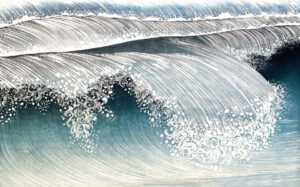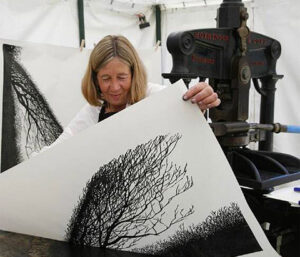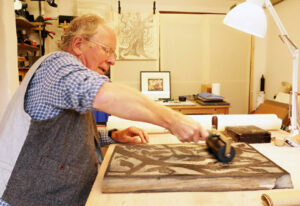Learning in lockdown – passing on the ancient art of woodblock printing
2nd October 2020 | OUR STORIES
In recent months there has been a meteoric surge in the pursuit of arts and crafts as we spend more time than ever at home. Global crisis aside, the creative and curious amongst us have used this time as a force for good, taking up lapsed hobbies or learning new skills. In response to a chaotic world which we cannot control, there has been a heightened need to return to slower activities with tangible outcomes – away from our screens.
In the world of printmaking, there are many different genres, with block printing being one of the oldest, dating as far back as the 2nd century CE, originating in China. Many will associate this form of printing with world famous ‘The Great Wave off Kanagawa’ a Japanese ukiyo-e woodblock print by Katsushika Hokusai. With a few simple materials the myriad of possible woodcut effects are endless and the results can vary from delicate to dynamic.

‘Shore break’ by Rod Nelson
Two expert printmakers, Merlyn Chesterman RE and Rod Nelson, have championed the ancient art of printmaking for the past thirty years. They became friends through a common enthusiasm for the work of Japanese printmaker Shiko Manukata. Much of their work draws on the vibrant living traditions of China and Japan using techniques and tools that are still in use in modern printmaking – the bamboo leaf covered baren and pink painted woodblocks both originate from China.

Merlyn Chesterman
Each has exhibited widely, published books, taught and have become experts in their field, and most recently they have produced a two hour masterclass DVD published by and available from Artisan Media called
Making Woodblock Prints. The nine topics include essential tools, cutting a block, developing your own marks, introducing colour, layer blocks with colour, cutting an underblock, inking the block, proofing and editioning, and advanced printing techniques.
“Let us consider for a moment Hokusai’s woodcut ‘The Great Wave off Kanagawa’ – probably the most famous woodcut print of all time – there is hardly anyone who is not excited by this masterpiece when seeing it for the first time (or even for the hundredth). It is visually as accessible to a six year old as to a Professor of Art. He knew that he was good.” Rod Nelson.

Rod Nelson
It was these 17th century printmakers that so enamoured the post impressionists; Monet, Degas and Van Gogh. Japonism was closely associated with the group and Monet in particular amassed a collection of around fifty prints by Utamaro, Hokusai and Hiroshige. Monet examined these prints intensely and their influence is felt in his art and gardens at Giverny, in the flower covered lake and Japanese footbridge. He welcomed Japanese visitors, buyers and admirers with whom he forged lifelong friendships. Van Gogh’s Iris paintings were directly influenced by ukiyo-e prints seen in the dark contours and expressive brushstrokes.
“Woodcuts are images that simply can’t be made in any other way. They sit on the boundary between art and craft – and anyone making woodcuts will quickly experience the delights and terrors of both.” – Rod Nelson
